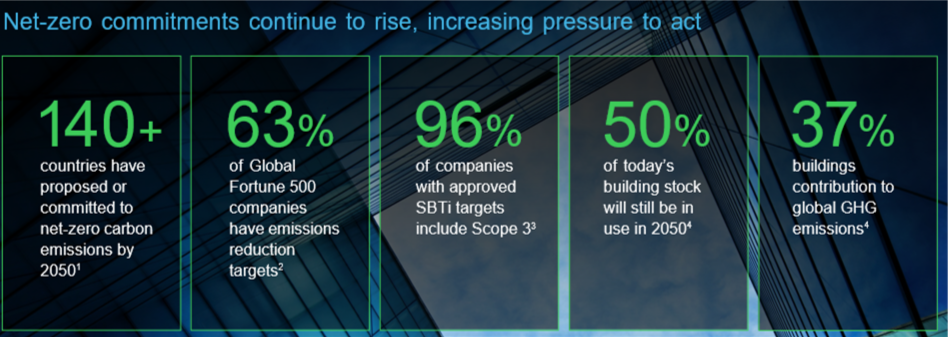Facility managers today face many challenges, including:
• Managing multiple systems and deploying IoT technology to ensure all buildings are energy and operationally efficient
• Prioritizing the health, safety, and productivity of occupants
• Achieving these goals with less time and fewer resources
However, another mission that is equally as important, is helping transform buildings for net-zero carbon emissions.
Why now? Let’s consider these trends:

Additionally, 70% of operational carbon emissions occur during the operation and maintenance stages of a building lifecycle, when facilities management can have the greatest influence and impact.
Getting started
Setting your net-zero strategy is crucial to success — developing a business case, identifying the business values, and return on investment for each proposed activity. Taking the first step can be the most daunting, so we've compiled this convenient list of resources to help you embark on a decarbonization journey knowledgeably, efficiently, and confidently.
1. Understanding where the role of facilities management fits in.
If you are a facility manager or director, you have extensive knowledge of how your buildings operate and are in an ideal position to provide strategic and operational guidance, from C-level management; to IT, human resources, legal and purchasing teams; to tenants. Facility managers should be involved in discussions about which objectives are achievable and how.
Read: Facility Management and Sustainability: A Fundamental Alliance
This guide explores use cases and examples of where you and your team can be proactive contributors to decarbonization success.
2. Know what it means to be net zero and the external forces driving this demand in the industry.
Read: Retrofit for Sustainability: A Facility Manager’s Guide to Net-Zero Buildings
This eGuide answers questions and describes a clear path for retrofitting buildings for net zero. It includes valuable information such as:
o Drivers of net-zero retrofits and why all-electric, all-digital buildings enable sustainability
o A proven 3-step roadmap to decarbonization (Strategize, Digitize, and Decarbonize)
o Creating a business case and identifying potential savings
o Case studies demonstrating transformation acceleration successes
3. Evaluate where you stand on your net-zero journey.
Read: Retrofit for Sustainability: Operational Checklist
The eGuide above is packed with valuable information, but if you’re short on time, go straight to its Operational Checklist. It provides a detailed assessment of your journey and suggests the next steps for your specific roadmap.
4. Adopt environmental, social, and governance (ESG) practices and promote sustainability to stakeholders helps you contribute to a more responsibly built environment.
Read: ESG + Facility Management
Global trends and responses to climate events are driving change in buildings. Facilities management plays a unique role in promoting sustainable practices and reducing the environmental impact of buildings and facilities. This resource provides more detail and outlines seven steps for integrating ESGs into facility management operations.
5. Understand 2030 Sustainable Development Goals.
Listen: SDG, NGO, DEI, GWI: The ABCs of Sustainable Development
In this podcast, IFMA and the IFMA Foundation team up in a series, "Rework: The Sustainable Development Chronicles." This episode describes the 2030 Sustainable Development Goals (SDGs) and Diversity, Equity, and Inclusion through the Global Workforce Initiative (GWI).
6. Obtain sustainability credentials.
Learn: Sustainability Facility Professional Credential
Once you fully understand the scope of the net-zero journey, put your knowledge to the test. This is IFMA’s leading credential for you to meet the increased needs for sustainable operations and improve the triple bottom line for your company.
Net-zero buildings in action
The journey to net-zero carbon is challenging but by no means impossible! For some inspiration, take a look at this case study on Aspiria. This multi-use real estate complex was able to reduce annual energy consumption by 16%, decrease its CO2 footprint by 36%, and gain a return on its investment within two years.
For other resources and information, please visit IFMA’s Knowledge Library or SE.com.
Editor's Note: This blog is in collaboration with our Corporate Sustaining Partner, Schneider Electric. Schneider Electric leads the digital transformation of energy management and automation. From energy and sustainability consulting to optimizing the lifecycle of your assets, SE provides products and services to meet your needs. Their technologies help you become more efficient, reduce costs, and meet your sustainability goals.














.png?width=352&name=MicrosoftTeams-image%20(46).png)
